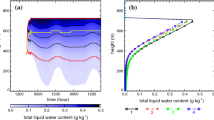Abstract
Pollutant scavenging parameterizations have been combined with meteorological predictions in a three-dimensional mesoscale numerical model (1). This meteorological model with detailed quasi-spectral microphysics is well-suited to include gas and aerosol removal by cloud droplets and raindrops. Two-dimensional sensitivity tests have been performed for both meteorological and chemical scenarios. Both maritime and continental clouds over an idealized topography have been considered to determine their relative efficiencies for wet sulfur deposition. A second example deals with night-time nitric acid production which has been simulated in a case of moist advection. A threshold behaviour for NO3 disappearance at relative humidities above 60 % was observed in agreement with experiments. The results obtained through such idealized tests emphasize the need for simultaneous treatment of dynamical, microphysical and physicochemical processes.
Similar content being viewed by others
References
Nickerson, E.C., Richard, E., Rosset, R. and Smith, D.R.: 1986,“The numerical simulation of clouds, rain and airflow over the Vosges and Black Forest mountains: a meso-model with parameterized microphysics”, Mon. Wea. Rev., 114, 398–414.
Richard, E., Chaumerliac, N. and Mahfouf, J.F.: 1987, “Numerical simulation of orographic enhancement of rain with a mesoscale model” J. Climate Appl. Meteor., 26, 661–669.
Mahfouf, J.F., Richard, E. and Mascart, P.: 1987, “The influence of the soil and vegetation and the development of mesoscale circulations”, J. Climate Appl. Meteor., in press.
Orlanski, I.: 1976, “A simple boundary condition for unbounded hyperbolic flows” J. Comput. Phys., 21, 251–269.
Chaumerliac, N., Nickerson, E.C. and Rosset, R.: 1986, “A 3D mesoscale model as a potential tool for the evaluation of sulfate particles scavenging”, Annales Geophys., 4, B, 3, 345–352.
Chaumerliac, N., Richard, E. and Nickerson, E.C.: 1987, “Sulfur scavenging in a mesoscale meteorological model with semi-spectral microphysics” J. Geophys. Res., 92, nℴ D3, 3114–3126.
Berry, E.X. and Reinhard, R.L.: 1973, “Modeling of condensation and collection within clouds” D.R.I. Phys. Sci. Pub., 16, University of Nevada.
Dingle, A.N. and Lee, Y.: 1973, “An analysis of in-cloud scavenging” J. Appl. Meteor., 12, 1295–1302.
Dana, J. and Hales, J.M.: 1976, “Statistical aspects of the washout of polydisperse aerosols”, Atmos. Environ., 10, 45–50.
Hegg, D.A., Rutledge, S.A. and Hobbs, P.V.: 1984, “A numerical model for sulfur chemistry in warm-frontal rainbands” J. Geophys. Res., 89, 7133–7147.
Maahs, H.G.: 1983, “Kinetics and mechanisms of the oxidation of S(IV) by ozone in aqueous solution with particular reference to SO2 conversion in non-urban tropospheric clouds” J. Geophys. Res., 88, 10721–10732.
Martin L.R.: 1983, “Kinetics studies of sulfite oxidation in aqueous solution”, Acid Precipitation J.G. Calvert, Ed., Ann Arbor Science.
Georgii, H.W.: 1978, “Large scale spatial and temporal distribution of sulphur compounds”, Atmos. Environ., 12, 681–690.
Heikes, B.G. and Thompson, A.M.: 1983, “Effects of heterogeneous processes on NO3, HONO and HNO3 chemistry in the troposphere”, J. Geophys. Res., 89, 11829.
Platt, U. and Perner, D.: 1980, “Detection of NO3 in the polluted troposphere by differential optical absorption”, Geophys. Res. Lett., 7, 89–92.
Author information
Authors and Affiliations
Rights and permissions
About this article
Cite this article
Chaumerliac, N., Rosset, R. Pollutant scavenging in a mesoscale meteorological model with quasi-spectral microphysics. Boundary-Layer Meteorol 41, 355–366 (1987). https://doi.org/10.1007/BF00120451
Issue Date:
DOI: https://doi.org/10.1007/BF00120451




